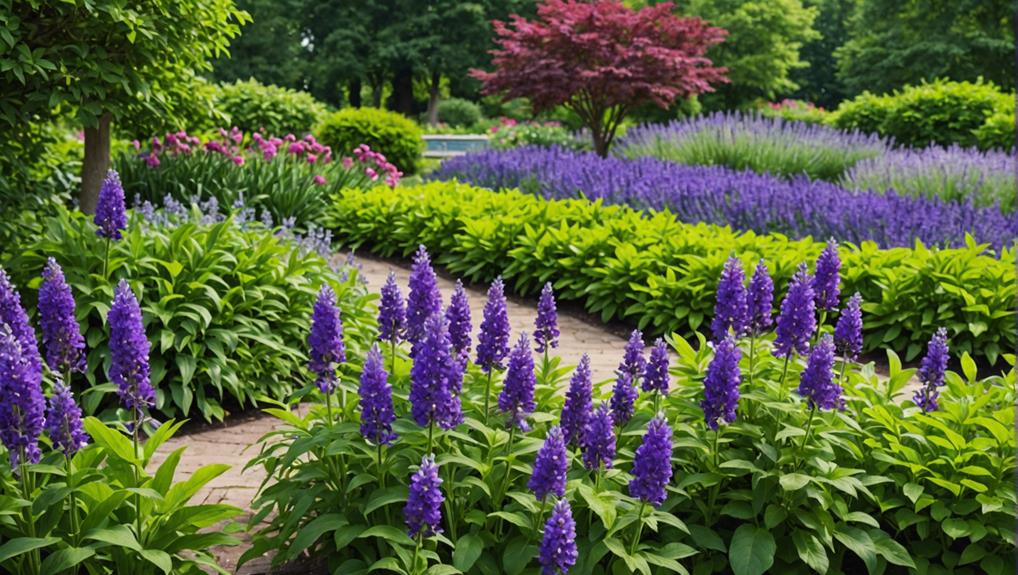
5 Stunning Outdoor Purple Plants for Your Garden
Transform your garden with five stunning outdoor purple plants. Lavender (Lavandula spp.) thrives in USDA Zones 5-9, needing full sun, well-drained soil, and sparse watering. Lilac (Syringa spp.) offers fragrant, showy clusters; make sure to provide full sun and prune after flowering. Clematis adds vertical interest with varieties like 'Jackmanii' flourishing in sun to part shade; proper pruning is essential. Butterfly Bush (Buddleja spp.) attracts pollinators and blooms from summer to fall in full sun. Purple Coneflower (Echinacea purpurea) dazzles with vibrant petals and is low-maintenance, needing moderate watering. There's so much more to perfect these garden gems.
Key Takeaways
- Lavender features vibrant purple flowers, thrives in full sun, well-drained soil, and is a pollinator magnet.
- Lilac offers enchanting fragrance, showy blooms, grows up to 15 feet tall, and prefers full sun and well-drained soil.
- Clematis provides vertical interest with various purple hues, thrives in full sun to part shade, and requires specific pruning techniques.
- Butterfly Bush has elongated clusters of purple flowers, attracts butterflies, blooms from summer to fall, and grows up to 6-10 feet tall.
- Purple Coneflower features vibrant purple petals, long-lasting blooms from midsummer to fall, and is low-maintenance with full sun to partial shade.
Lavender
Lavender (Lavandula) thrives in USDA Zones 5-9, making it a resilient and aromatic addition to your garden with its vibrant purple flowers and slender spikes. This plant isn't just about beauty; it's also a magnet for pollinators like bees and butterflies. Among the popular lavender varieties are Lavandula angustifolia (English Lavender), Lavandula x intermedia (Lavandin), and Lavandula stoechas (Spanish Lavender), each offering unique attributes and care requirements.
For ideal growth, follow essential lavender care tips. Plant your lavender in well-drained soil, ideally sandy or gravelly, to prevent root rot. Full sun exposure is crucial, as Lavandula requires at least six hours of direct sunlight daily. Water sparingly; lavender is drought-tolerant and prefers to dry out between waterings. Pruning is essential for maintaining its shape and encouraging new growth. Trim back one-third of the plant in late summer, avoiding cutting into woody stems.
Amend the soil with lime if you have acidic conditions, as lavender thrives in a pH range of 6.5 to 7.5. Mulch with light-colored gravel to reflect sunlight and maintain soil dryness.
Lilac
Lilacs (Syringa) are renowned for their enchanting fragrance and vibrant, showy clusters of blooms, making them a quintessential choice for spring gardens. These deciduous shrubs can grow up to 15 feet tall and prefer full sun and well-drained soil. Varieties like Syringa vulgaris 'Sensation' feature striking bicolor blooms with deep purple edges and white centers, adding a unique touch to your landscape.
To guarantee your lilacs thrive, focus on proper care. Lilac pruning is essential; prune immediately after flowering to promote new growth and enhance next year's blooms. For optimal development, use balanced fertilizers in early spring. Lilac propagation is typically done through cuttings or layering, allowing you to expand your garden with ease.
However, lilacs can face issues from common pests like lilac borers and aphids. Regular monitoring and appropriate treatments can keep your plants healthy. Here's a quick reference table for lilac care:
| Aspect | Details |
|---|---|
| Sunlight | Full sun |
| Soil | Well-drained |
| Pruning Time | Immediately after flowering |
| Common Pests | Lilac borers, aphids |
| Best Fertilizers | Balanced fertilizers in early spring |
| Propagation | Cuttings or layering |
| Height | Up to 15 feet |
| Attraction | Butterflies, hummingbirds |
Clematis
While lilacs provide a stunning springtime display, Clematis (Clematis spp.) offers a versatile and dynamic option for adding vertical interest to your garden with its broad spectrum of purple hues and impressive floral architecture. This climbing vine thrives in full sun to part shade, making it adaptable to various garden conditions. Clematis care is crucial for vigorous growth and abundant blooms.
To guarantee your Clematis flourishes, consider these care and propagation tips:
- Light and Soil Requirements: Clematis prefers well-drained soil rich in organic matter and requires at least 6 hours of sunlight daily. However, roots should be kept cool, often achieved by mulching.
- Watering and Feeding: Keep soil consistently moist but not waterlogged. Fertilize with a balanced, slow-release fertilizer in early spring.
- Pruning Techniques: Prune based on the group your Clematis belongs to. Group 1 (spring-blooming) needs minimal pruning, Group 2 (early summer) benefits from light pruning, and Group 3 (late summer/fall) requires hard pruning.
- Propagation Methods: Propagate through softwood cuttings in late spring or by layering in late summer. Ensure cuttings have at least one node for successful rooting.
Popular purple Clematis varieties include 'Jackmanii' and 'The President.' Proper pruning techniques will enhance their flowering potential, ensuring a vibrant display of purple blooms in your garden.
Butterfly Bush
The Butterfly Bush (Buddleia spp.) captivates gardeners with its elongated clusters of purple, pink, or white flowers that lure butterflies and other pollinators to your garden. Blooming from summer to fall, Buddleia adds vibrant color and beauty to your outdoor space. This plant thrives in full sun and well-drained soil, making it a low-maintenance addition to your garden that can grow up to 6-10 feet tall.
To guarantee robust growth, observe specific soil requirements. Butterfly Bush prefers slightly acidic to neutral pH and well-draining soil. Pruning tips include cutting back the plant in late winter or early spring to encourage new growth and maintain its shape. Prune old wood and dead branches to keep the plant healthy and vigorous.
For propagation methods, you can use softwood cuttings in early summer or hardwood cuttings in late fall. Be mindful of pests and diseases such as spider mites, aphids, and root rot, which can affect Buddleia. Regular inspection and timely intervention with appropriate treatments will keep these issues at bay.
Purple Coneflower
Enhance your garden's aesthetic with the Purple Coneflower (Echinacea purpurea), a hardy perennial that dazzles with its vibrant purple petals and striking orange-brown centers. This native North American plant is a favorite in garden design due to its easy-care nature and bold appearance. It's not just about looks—Echinacea purpurea offers herbal benefits, known for boosting the immune system and promoting overall wellness.
Incorporate Purple Coneflower into your garden to boost pollinator attraction, drawing in butterflies and bees. This makes it a perfect addition for native landscaping enthusiasts. With its long-lasting blooms from midsummer to fall, you'll enjoy a dynamic, colorful display with minimal effort.
To thrive, follow these expert care tips:
- Sunlight: Make sure your Purple Coneflower gets full sun to partial shade.
- Soil: Plant in well-drained soil; it's drought-tolerant but thrives best in moderately fertile ground.
- Watering: Water moderately; established plants are quite drought-resistant.
- Pruning: Deadhead spent flowers to encourage continuous blooming and prevent self-seeding.
Integrating Echinacea purpurea into your garden not only enhances its visual appeal but also supports local ecosystems and offers medicinal value.
Frequently Asked Questions
What's the Prettiest Purple Flower?
You might find Iris types like Iris germanica Grape Adventure with rich violet blooms or Lavender varieties such as Lavandula angustifolia appealing. Both require well-drained soil and full sun, enhancing your garden's elegance and fragrance.
What Is a Hardy Purple Flowered Plant?
When considering hardy purple flowered plants, try drought-tolerant varieties like Lavandula angustifolia (lavender) or perennial options like Salvia nemorosa (wood sage). These resilient plants require minimal maintenance and can thrive in various climates.
What Is the Purple Flower Spreading Plant?
The purple flower spreading plant you're asking about is the Purple Heart (Tradescantia pallida). Similar options include Purple Verbena (Verbena bonariensis) and Perennial Vinca (Vinca minor), which also offer vibrant color and easy maintenance.
What Is the Purple Flower That Grows Close to the Ground?
The purple flower that grows close to the ground is Phlox subulata, also known as creeping phlox. This ground cover is low maintenance, drought-tolerant, and ideal for sunny areas, attracting pollinators while forming a dense mat.
Conclusion
Incorporating these stunning purple plants into your garden will surely add vibrant color and elegance. By planting Lavandula angustifolia (Lavender), Syringa vulgaris (Lilac), Clematis 'Jackmanii' (Clematis), Buddleja davidii (Butterfly Bush), and Echinacea purpurea (Purple Coneflower), you're providing both aesthetic beauty and ecological benefits.
Guarantee proper sunlight, well-drained soil, and regular pruning to maintain their health. With expert care, these plants will thrive and transform your outdoor space into a botanical masterpiece.



Leave a Reply